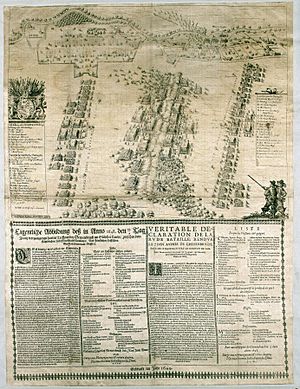Battle of Wevelinghoven facts for kids
Quick facts for kids Battle of Wevelinghoven |
|||||||
|---|---|---|---|---|---|---|---|
| Part of Thirty Years' War | |||||||
 |
|||||||
|
|||||||
| Belligerents | |||||||
| Commanders and leaders | |||||||
| Strength | |||||||
| 6,500 men 11 guns |
4,600 men 5 guns |
||||||
| Casualties and losses | |||||||
| 1,000 dead 1,500 captured 11 guns captured |
168 dead 180 wounded 70 captured |
||||||
The Battle of Wevelinghoven was an important fight near the end of the Thirty Years' War. It happened on June 14, 1648. This battle was fought between soldiers from the Holy Roman Empire and the winning side, Hesse-Cassel. Some old records say it happened on June 4.
What Led to the Battle?
The Hessian army, led by General Johann von Geyso, was staying in Neuss. They were there as an occupying power, meaning they had taken control of the area. South of them, in the Electorate of Cologne, were the Imperial Troops. These troops were led by Field Marshal Guillaume de Lamboy.
The area called the Duchy of Jülich-Berg was neutral. This meant they didn't pick a side in the war. When the Hessian troops started marching towards Grevenbroich, which was part of Jülich, the Duke of Jülich-Berg, Wolfgang William, got worried. He feared that if the Hessians took Grevenbroich, the Imperial side would see it as a reason to ignore Jülich-Berg's neutrality.
So, Duke Wolfgang William asked General von Geyso to promise that Grevenbroich would be safe. Because of this promise, the Hessians did not take over Grevenbroich. Instead, they set up camp near Wevelinghoven. Their plan was to go back to Neuss.
The Battle Begins
Lamboy's Imperial army, with about 6,500 soldiers, moved forward. On June 13, they positioned themselves in front of the Hessian camp. However, the Hessians did not start fighting right away. Instead, they moved back to a spot they had prepared earlier. This spot was between Grevenbroich and Wevelinghoven. Their goal was to cross the Erft river there and head towards Neuss.
The Imperial soldiers chased after them. They wanted to stop the Hessians from leaving and cut off their supplies. But General von Geyso had expected this plan. He waited for the Imperial troops, ready for battle.
Around 5 AM on June 14, the two armies crashed into each other. Even though the Imperial army had almost twice as many soldiers, they had to retreat. The fighting lasted for five hours. During this time, the Imperial army lost about 1,000 soldiers and 1,500 were captured. The Hessians also captured eleven cannons. The Hessians had much fewer losses, with only 168 soldiers killed.
What Happened Next?
After the battle, the Imperial troops went back to Bonn to rest and get new supplies. The Hessian army camped between Uerdingen and Linn. They stayed there quietly until September.
In September, General von Geyso and the Hessian army started to besiege Düren. This means they surrounded the city to try and capture it. They succeeded on September 21, even though Lamboy tried to help the city. After this, the Hessians planned to besiege Paderborn. But Lamboy arrived and saved Paderborn on October 17.
News of the Peace of Westphalia reached the soldiers at the end of October. This peace treaty officially ended the Thirty Years' War. At that time, the Imperial troops were near Höxter, and the Hessians were near Brakel.

